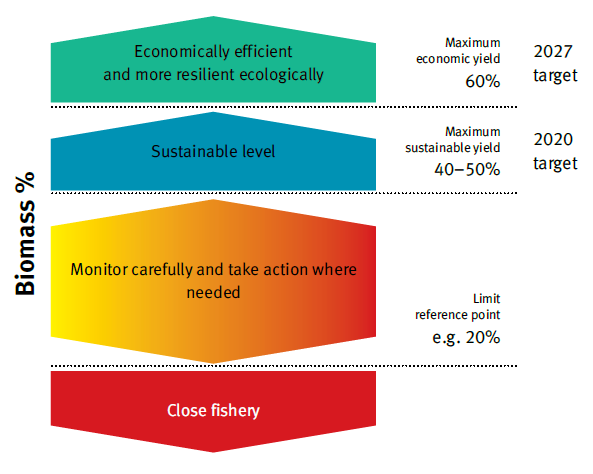Harvest strategies
A harvest strategy specifies pre-determined management actions necessary to achieve ecological, economic and/or social objectives of a fishery.
Fisheries Queensland worked with stakeholders to develop harvest strategies for most of Queensland’s fisheries. Fishery working groups, the Sustainable Fisheries Expert Panel and meetings with stakeholders all played an important role in identifying objectives, timeframes, indicators and reference points that formed the basis of each harvest strategy.
Harvest strategies for Queensland fisheries
The Queensland harvest strategy policy (PDF, 1.46MB) provides a framework to guide development and implementation of the harvest strategies. Read about how the harvest strategies work (PDF, 290.9KB).
-
Crab fisheries
- Blue swimmer crab harvest strategy (commencing from 1 September 2021)
- Mud crab harvest strategy (commencing from 1 September 2021)
- Spanner crab harvest strategy
- How we’re managing the spanner crab fishery
-
Coral and marine aquarium fish fisheries
- Coral harvest strategy (commencing from 1 September 2021)
- Marine aquarium fish harvest strategy (commencing from 1 September 2021)
-
East coast inshore fishery
- East coast inshore harvest strategy (commencing from 1 September 2021)
- East coast inshore protected species management strategy (commencing from 1 September 2021)
-
East coast Spanish mackerel fishery
- East coast Spanish mackerel harvest strategy (commencing from 1 July 2023)
-
Gulf of Carpentaria inshore fishery
-
Reef line fishery
-
Sea cucumber fishery
- Sea cucumber harvest strategy (commencing from 1 September 2021)
-
Trawl fin fish (stout whiting) fishery
- Commercial trawl fin fish (stout whiting) harvest strategy (commencing from 1 September 2021)
-
Trawl fisheries
- Northern trawl region harvest strategy (commencing from 1 September 2021)
- Central trawl region harvest strategy (commencing from 1 September 2021)
- Southern inshore trawl region harvest strategy (commencing from 1 September 2021)
- Southern offshore trawl region harvest strategy (commencing from 1 September 2021)
- Moreton Bay trawl region harvest strategy (commencing from 1 September 2021)
-
Tropical rocklobster fishery
- Crayfish and tropical rocklobster harvest strategy (commencing from 1 September 2021)
How harvest strategies work
Harvest strategies provide clarity about the overall fishery objectives, fishery performance indicators, triggers for management action and appropriate management responses/decision rules.
- Objectives
Fishery objectives outline where we want the fishery to be from an ecological, economic and social (triple bottom line) perspective and the time frame to achieve those objectives.
- Indicators
Harvest strategies use data and information to track the performance of the fishery over time. Such sources of information are known as indicators. These include things like biomass, catch rates, protected species interactions etc.
- Reference points
- Decision rules
To translate objectives into something tangible, harvest strategies establish reference points for a fishery. Reference points describe desirable and undesirable levels of performance in the fishery.
Target Reference Points (TRP) is where we want the stock to be and describes a desirable level of performance. If a fishery is performing at or above its Target Reference Point; the fishery may be able to support additional levels of catch or fishing effort.
Trigger Reference Points (TrRP) is a point where management intervention is needed to move the fishery towards its objective. This may involve taking action to reduce the amount of catch or fishing pressure in the fishery in order to allow fish stocks to recover.
Limit Reference Points (LRP) describe the point at which the performance of the fishery is considered unacceptable and more drastic management action is immediately required. This could involve significantly reducing the level of catch or effort in the fishery or closing the fishery altogether to allow fish stocks to recover

Figure 1: Example of target and limit reference points for stock biomass.
The decision rules clearly state what pre-determined management action will be taken under certain circumstances. This usually involves adjusting (through quota, management units or bag limits etc.) the catch or fishing pressure in the fishery. By being clear about what action will be taken and when, harvest strategies help remove much of the uncertainty around how a fishery will be managed.
More information
The Queensland Harvest Strategy Policy and Guidelines for Implementing the Queensland Harvest Strategy Policy have guided the development of the harvest strategies by the fishery working groups and Sustainable Fisheries Expert Panel.